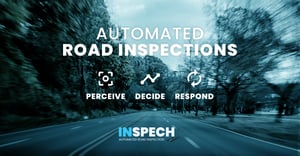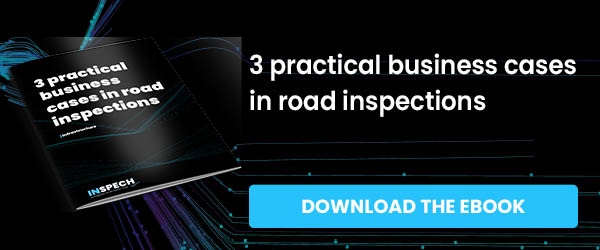There is a lot of talk about Artificial Intelligence (AI), but sometimes it is hard to understand how it affects (and improves) our everyday lives. Especially in the long run. But here we have an excellent example for you that might even affect your daily life - if you use the A-lanes in the Rotterdam area. It is in this area that an AI-driven digital road inspector assists human road inspectors to keep the roads whole.
How it all began
We all want our roads to be safe, and road inspection contributes to that by signalling damages and predicting maintenance. The A-Lanes A15 is a consortium that has been commissioned to widen the A15 motorway between the Dutch Maasvlakte and Vaanplein in the wider Rotterdam area. The Department of Public Works issued a Design, Build, Finance & Maintain (DBFM) agreement to the consortium, a collaboration between Ballast Nedam, John Laing and Strukton. The consortium will act as the operating company for the management and maintenance organization for 25 years during the construction and operation phases. To execute this plan, the A-lanes A15 consortium has chosen INSPECH for a digital inspector.
The site
The area includes 37 km of motorway, the Botlek tunnel, the Thomassen tunnel and the Botlek bridge. Annually, the consortium has to demonstrate the contract requirements are being met for road surfacing and draw up an annual asphalt repair plan.
In 2020 Unihorn (pavement research and consultancy) is asked to record the visual condition of the pavements on 470 km of carriageways and emergency lanes using Horus HD video images. The damage is identified according to the Rijkswaterstaat visual inspection methodology (the DWW method).
A matching solution for inspection challenges
Besides the shortage of qualified inspectors, human visual road surface inspections are labour-intensive and costly. In addition, inspections must be performed in daylight, which is unsafe and challenging on busy roads.
The A-lanes A15 consortium hires INSPECH to overcome these challenges. The digital inspector from INSPECH takes over domain knowledge from a human road inspector with intelligent technology. Now the visual road inspection can be extensively automated. The road no longer needs to be checked just by people, allowing road inspections to be performed more consistently, faster and safer at lower operational costs.
With INSPECH the repetitive visual tasks, like watching kilometres of video footage, is done by an AI-solution. Every 5 meters has to be annotated with road damages. This typically takes 6 weeks for a highway and 6 months for municipalities when only human inspectors are on the job. But a digital inspector can take over the ‘boring bulk work’. The role of the human road inspector becomes more or less like a supervisor or a coach. And the time that is reclaimed, can be used by the human inspector for high value work. The digital inspector augments the human inspector with faster, safer, more consistent actionable insights to make better decisions.
The Dashboard
INSPECH provides a dashboard, so road inspectors are always fully aware of the current status of the road surface. This provides immediate insights into the area, such as pavement condition and road markings. The dashboard automatically displays the type of damage, including the severity classes, the extent and the geographical coordinates of the damage. With this information, A-lanes can take immediate action to repair the damage to the road surface. With INSPECH, A-lanes can automatically check road surface quality.
The features
The digital road inspector automatically assesses road sections according to the guidelines of Rijkswaterstaat. The state of the surface is accessible on a digital map where coloured road sections automatically mark damages. Inspectors can see exactly which part of the road needs maintenance. This feature also plots specific damage on the map based on orthographic images so that road inspectors can check specific road sections from their computer based on current photos. The analyses can be automatically linked to international guidelines, such as the Dutch CROW or DWW regulations. As a result, INSPECH automatically displays the scores of the official guidelines, allowing for a more proactive maintenance regime.
This will allow A-Lanes to solve challenges earlier in the life cycle of the roads. By protecting, preserving, and rejuvenating roads in good condition, damage can be limited significantly. Roads can be prepared for major treatments such as surface dressing. The early intervention treatments are not only cost-effective, but they are also significantly contributing to carbon savings.
Quick training for new coating and damages
A unique feature of this project is the overlay mixture OPA8 that has to be inspected. This is a fine, very open asphalt concrete with a high percentage of hollow space (25%). The mixture differs considerably from the regular ZOAB overlays. The main damage pattern in such overlays is fraying. For OPA8, INSPECH had to undergo additional training, which could be done quickly with good results. This proves that INSPECH can also be trained and used quickly and flexibly for new coatings and damages.
The Future
Currently, we are working on the further development of INSPECH. An exciting project is the comparison of inspection results from different periods. Something that fits exceptionally well with a project containing a maintenance component. Additionally, it will be possible to determine road deterioration trends and predict the most appropriate time for maintenance. This way, maintenance is not carried out too early and not too late, so maintenance funds can be used optimally.
Find out how INSPECH helps to inspect roads and download our free ebook:

